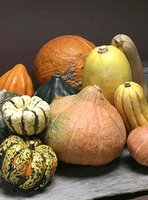Fall's golden globes
 Don't let the name fool you. Winter squash are here now -- and they are demanding star treatment.
Don't let the name fool you. Winter squash are here now -- and they are demanding star treatment.By Russ Parsons, LA Times
If you've been to the produce section of your local grocery store in the last few weeks, you've seen winter squash all over the place. I've seen them, and haven't been quite sure if they're all good for eating, or if they are more for a fall decoration to have around to be "in the season".
Parsons goes through the varities of winter squash and how to select them, and of course, how to cook them.
There are four main varieties:
• Acorn. This is probably the most familiar winter squash after the pumpkin and almost certainly the most familiar one that is edible. Its skin is dark green with occasional blushes of saturated orange. Its flesh is pale to medium orange. The texture is semi-smooth and rich, and flavor is moderately sweet and moderately squashy. The acorn is a middle-of-the-road squash. The Table Queen is an especially good type of acorn.
• Butternut. If I had to choose a single readily available winter squash variety, this would be it. The butternut is shaped like a long cylinder with a slight bulb on one end. The skin is fairly thin and a kind of golden tan in color. The flesh is dark orange and semi-fibrous. The flavor is very sweet and nutty with just a hint of green squashiness.
• Carnival. This looks like a harlequin acorn squash, with beautiful patchwork dark green and bright orange skin. The flesh is dark orange and slightly fibrous. The flavor is complex, rich and sweet with an intriguing earthy note.
• Kabocha. Though it became available only in the last decade or so, the kabocha seems to be everywhere today. It is round and slightly flattened at the top and bottom. The skin is dark green with delicate gray-blue tracing (there are also all-green and dark-orange versions). The flesh is pale to medium orange and extremely dense and smooth. The flavor is very sweet but with a nice green squashy edge that gives some backbone.

